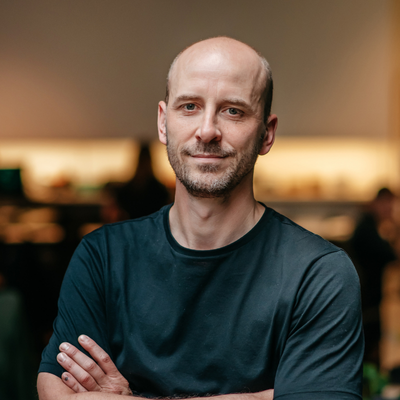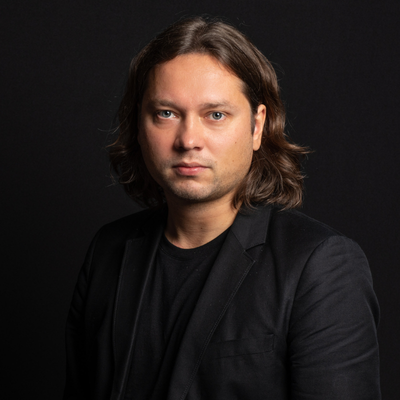
AI is no longer an abstract concept, but an everyday panacea to all the time-consuming inefficiencies of a modern interior design studio. It is still regarded in some workspaces as a spectral, betentacled presence, seeping into workstreams in ways senior leadership cannot quite grasp, or fail to value.
However, AI is genuinely transforming how some studios create, present, and deliver work in positive ways. To discover more about how generative AI tools are actually being used in studios today, and to dispel some of the fear and even shame associated with their use, we spoke to three leading designers share how they are introducing AI into their workflows, and why the technology isn’t a threat but a catalyst for better outcomes.

Lead Design Architect, OBMI
Drew Gilbert, OBMI
Drew Gilbert, a Lead Design Architect at global hospitality design firm OBMI, describes his team’s work with AI as an “extension of our thinking,” a way to align internal project stakeholders around a shared vision more quickly and precisely. For Gilbert, “it’s a core layer woven into the entire design and delivery process.” AI is even used at the outset of a new project. “The process no longer begins with a pencil sketch but with a prompt,” he says.
Rather than replacing human input, AI helps Gilbert and his team align faster across disciplines. “It gives our designers, visualisers, and strategists a shared language to test and communicate concepts with greater precision. We use it to strengthen storytelling, sharpen presentation quality, and iterate more fluidly with clients. AI has shifted how we approach design. It is not just helping us produce more. It is helping us focus our creativity where it matters most.”
Gilbert describes using AI to reshape scenes, remove elements, enhance realism, and visualise concepts as “having a superpower,” noting the “surreal clarity” the studio can achieve in seconds to break down barriers between vision and execution. “It gives every team member, from junior designers to senior leads, the ability to communicate ideas more clearly and confidently, unlocking creative potential across the board.”
Crucially, Gilbert emphasises that AI doesn’t replace authorship. “It cannot replace a job you never handed over, but it can eliminate the tedious and repetitive work that distracts from what we actually care about,” he says, adding that the OBMI team is “[looking] for the balance that gives us both efficiency and meaning. That’s where the real value lies
Dave Bullock, Hayes Davidson
At Hayes Davidson, a visualisation studio, AI is not simply about faster production, but also about dialling-up creativity and improving quality. Dave Bullock, Principle Creative Director, describes AI in the context of his studio’s work as, “an incredibly powerful set of tools that help create more compelling and realistic visuals across concept development and final delivery.”
One significant impact has been on how the studio manages to represent diversity in its visualisations. “Previously, it was very difficult to depict people from a broader spectrum of backgrounds convincingly because of the limitations of the resources at our disposal,” Bullock says. However, AI is helping to change that, and today, the studio can illustrate a much more diverse range of cultures and identities with precision and respect in its work.

Principle Creative Director, Hayes Davidson
Still, Bullock is aware of AI’s limitations. “Everything it generates has to be rigorously checked for accuracy, bias, and quality, just as we would with any artist’s contribution,” he says. The team at Hayes Davidson maintains careful oversight over how and where AI is deployed. For internal tasks like summarising meetings or researching references, AI saves time and frees up teams for higher-level thinking. But for client-facing work, everything passes through layers of human interrogation and careful editing.
For Bullock, the right approach is one that blends the benefits of AI with a human touch. “If everyone relies on the same generative models, everything risks looking the same,” Bullock says, “so human personality is necessary to cut through the noise.”

Regional Design Director, HKS London
Raffael Petrovic, HKS London
For Raffael Petrovic, the Regional Design Director at architecture firm, HKS London, AI has evolved rapidly from a novelty into a sophisticated design tool. Over the last couple of years that HKS has been using AI in studio design processes, Petrovic says, “we have seen its capabilities evolve rapidly, from surreal, hallucinatory images to photorealistic, animated scenes through simple prompts.”
When the practice first began using AI software, Petrovik says they served mostly as visual ideation tools, essentially as AI moodboards. “But,” he says, “with the rapid advances in large language models, we see its use shift more towards a design co-pilot - assisting in more complex tasks.”
Petrovic believes the key to tapping into AI’s potential lies in how designers frame their prompts. “Instead of asking, ‘Can you generate ten façade options,’ ask, ‘how can we rethink this façade to reduce embodied carbon?’” he says. Purposeful prompting transforms AI from a scattergun, inaccurate, wayward experimentation ground into a strategic desk-side partner that helps to drive projects forward. “By engaging with AI more purposefully, we can unlock its potential not just as a tool but as a design collaborator,” Petrovic says.
Even as generative models become more capable, it's clear that many designers maintain that human judgment remains indispensable in the studio. The technology should be seen as a close, fallible collaborator, not as a replacement for hard work. Thankfully, seems that across the industry, the focus is on using AI to raise the bar, not to lower the effort
Anya Cooklin-Lofting
Anya Cooklin-Lofting is a freelance journalist specialising in design, culture, and the arts.




